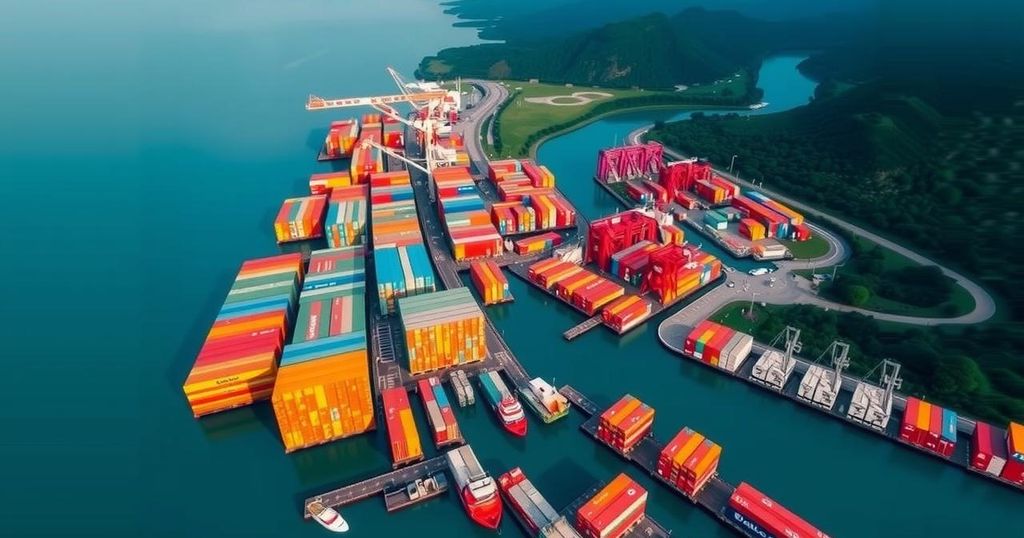Politics
AMERICA, ANTONY BLINKEN, ASIA, CALTRAIN, CHANCAY, CHINA, CHINESE NAVY, COSCO, DINA BOLUARTE, HIGH-LEVEL DIALOGUE, INVESTMENTS, LATIN AMERICA, LIMA, MEXICO, NORTH AMERICA, PANAMA CANAL, PERU, PERUVIAN, SHANGHAI, SOUTH AMERICA, SOUTH CHINA SEA, TERRITORIAL DISPUTE, TRADE, UNITED STATES, US, VOL, VOLCAN, XI JINPING
Dante Raeburn
China’s $1.3 Billion Investment in Chancay Port: A New Era in US-China Trade Relations
A $1.3 billion deep-water megaport in Chancay, Peru, inaugurated by leaders from China and Peru, is set to alter regional trade dynamics, particularly between the US and China. The port, capable of servicing large container ships, offers faster routes to Asia, raising concerns about shifting revenues and strategic military implications in Latin America. This development highlights growing criticisms regarding the US’s neglect in the region amidst China’s aggressive investments.
The inauguration of a $1.3 billion deep-water port in Chancay, Peru marks a significant development in the ongoing trade tensions between the United States and China. The Chancay port, facilitated by China’s state-owned enterprise Cosco and the local mining company Volcan, features 15 berths and is designed to accommodate large container ships that exceed the dimensions suitable for the Panama Canal. With an initial capacity of 1 to 1.5 million TEUs, this capacity is anticipated to increase to 3.5 million TEUs upon completion.
Geopolitically, the Chancay port enables the fastest maritime route to Shanghai, reducing travel time to just 23 days, which is 10 days shorter than the traditional Panama Canal route. As a result, US and Mexican port operators may experience diminished revenues, raising concerns among US analysts about potential military implications, should China leverage the port for naval operations in close proximity to the United States. The newfound infrastructure underscores China’s strategic focus on securing resources in Latin America, echoing criticisms regarding the US’s diminishing influence in the region.
The situation is compounded by contrasting US efforts, as exemplified by outgoing Secretary of State Antony Blinken’s recent $6 million offer to Peru involving outdated Caltrain diesel locomotives. Analysts assert that this inadequate response to China’s escalating investments in Latin America under the Belt and Road Initiative (BRI) highlights the US’s failure to effectively engage with its neighbors, allowing China to capitalize on available resources and gain geopolitical leverage.
Moreover, the establishment of exclusive operational rights for Cosco at the Chancay port has generated contention within Peru, marking a significant strategic shift. China, as Peru’s principal trade partner, heavily relies on exports such as copper, iron, and fishmeal, further solidifying this new port’s importance in regional trade dynamics.
The Chancay port is part of China’s larger Belt and Road Initiative, designed to enhance trade routes and increase China’s access to international markets. The initiative aims to connect Asia with Africa and Europe via land and maritime networks. In recent years, China has significantly boosted its investments in Latin America, a region rich in resources. This shift poses challenges for the United States, which has traditionally viewed the region as within its sphere of influence. The completion of the Chancay port is emblematic of a broader strategic competition between the US and China globally, particularly regarding access to resources and geopolitical dominance.
In conclusion, the opening of the Chancay port serves as a pivotal point in the ongoing trade rivalry between the US and China. With its strategic capabilities and logistical advantages, this port not only enhances China’s trade prospects in Latin America but also potentially reshapes the region’s geopolitical landscape. The contrasting approaches of the US and China in engaging with Peru and its resources further illustrate the challenges the United States faces in maintaining its influence amidst China’s rising presence in the region.
Original Source: gfmag.com








Post Comment